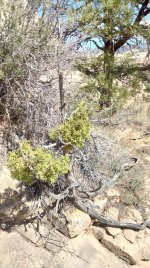BoondoxUtah
Seedling
I am sure this has been discussed before in more than one thread, but I've spent lots of time searching the forums and really haven't found what I am asking. I remember at least one answer that mentions taking time, sometimes significant time, in prepping the tree prior to digging. I have several pinyons and Junipers that are good candidates for digging, but if possible I would like to try and increase the root ball and feeder roots closer to the truck prior to digging. I can easily access these trees and can modify the area around the roots. I also can water the trees at least two to three times a week. So some specific questions: will nicking or scaring more established roots, then burying them in a decent rooting media, stimulate roots at the site of the cut? Will creating a healthy rooting zone near the tree, with supplemental watering encourage root growth? Since my access is so good to these trees (a 5 minute walk at most), I am thinking "why dig this tree, put it in a box for two to three years letting it recuperate and grow out the a new root system, when I could potentially leave the tree in the ground and concentrate on creating new roots in place before digging?" Thoughts? Techniques? Forget about it?


